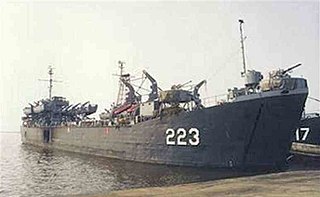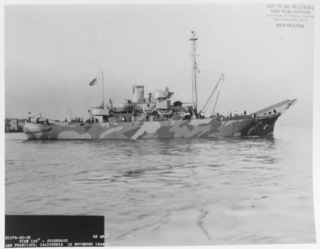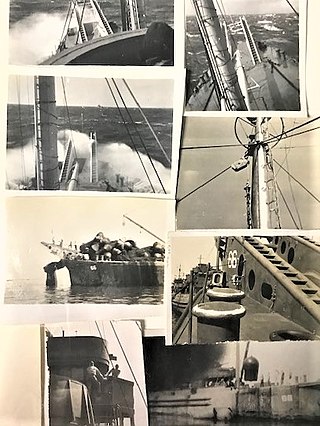
USS Butternut (AN-9/YN-4/ANL-9/YAG-60) was laid down as a yard net tender on 11 March 1941 at Houghton, Washington, by the Lake Washington Shipyard; launched on 10 May 1941; and placed in service at the Puget Sound Navy Yard on 3 September 1941.

USS Iron County (LST-840) was an LST-542-class tank landing ship built for the United States Navy during World War II. Named after counties in Michigan, Missouri, Utah, and Wisconsin, she was the only U.S. Naval vessel to bear the name.

USS Snowbell (YN-71/AN-52) was a Ailanthus-class net laying ship which served the U.S. Navy during World War II. She operated in the Pacific Ocean until she was destroyed by Typhoon Louise off Okinawa, 9 October 1945.
USS Chinquapin (YN-12/AN-17) was an Aloe-class net laying ship built for the United States Navy during World War II. Originally ordered as USS Fir (YN-2), she was renamed and renumbered to Chinquapin (YN-12) in October 1940 before construction began. She was launched in July 1941, and completed in October 1941. Placed in service at that time without being commissioned, she was commissioned in January 1943, and decommissioned in March 1946. She was placed in reserve at that time and scrapped in 1976.
USS Chinaberry (AN-61/YN-82) was a Ailanthus-class net laying ship which served the U.S. Navy during World War II. Chinaberry operated in both the Atlantic Ocean and the Pacific Ocean before being decommissioned at war's end.
USS Torchwood (AN-55/YN-74) was an Ailanthus-class net laying ship which served with the U.S. Navy in the Pacific Ocean theatre of operations during World War II. She performed her net laying services until war’s end, and then was given to the Republic of China.

USS Lancewood (AN-48/YN-67) was an Ailanthus-class net laying ship built for the United States Navy during World War II. In service in the Pacific during the war, she earned one battle star. After her February 1946 decommissioning, she was sold to France as Commandant Charcot. Her fate is not reported in secondary sources.
USS Canotia (AN-47/YN-66) was an Ailanthus-class net laying ship which served with the U.S. Navy in the South Pacific Ocean theatre of operations during World War II. Her career was without major incident, and she returned home after the war bearing one battle star to her credit.
USS Corkwood (AN-44/YN-63) was an Ailanthus-class net laying ship which served with the U.S. Navy in the western Pacific Ocean theatre of operations during World War II. Her career was without major incident, and she returned home safely after the war with one battle star to her credit.

USS Cliffrose (AN-42/YN-61) was an Ailanthus-class net laying ship which served with the U.S. Navy in the western Pacific Ocean theatre of operations during World War II. Her career was without major incident, and she returned home safely after the war with two battle stars to her credit.

USS Baretta (AN-41/YN-60) was an Ailanthus-class net laying ship which served with the U.S. Navy in the western Pacific Ocean theatre of operations during World War II. After surviving war action and Pacific Ocean typhoons, and she returned home safely after the war with one battle star to her credit.

USS Stagbush (AN-69/YN-93) was an Ailanthus-class net laying ship which served with the U.S. Navy in the western Pacific Ocean theatre of operations during World War II. Her career was without major incident, and she returned home safely after the war with one battle star to her credit.
USS Bitterbush (AN-39/YN-58) was an Ailanthus-class net laying ship which served with the U.S. Navy in the western Pacific Ocean theatre of operations during World War II. She served the U.S. Pacific Fleet with her protective anti-submarine nets, and returned home safely after the war with one battle star to her credit.
USS Mango (AN-24/YN-19) was an Aloe-class net laying ship which was assigned to serve the U.S. Navy during World War II with her protective anti-submarine nets.
USS Mahogany (AN-23/YN-18) was an Aloe-class net laying ship which was assigned to serve the U.S. Navy during World War II with her protective anti-submarine nets.

USS Elder (AN-20/YN-15) was an Aloe-class net laying ship which was assigned to serve the U.S. Navy during World War II with her protective anti-submarine nets.
USS Catalpa (AN-10/YN-5) was an Aloe-class net laying ship which was assigned to serve the U.S. Navy ships and harbors during World War II with her protective anti-submarine nets.

USS Aloe (AN-6/YN-1) was an Aloe-class net laying ship which was assigned to serve U.S. Navy ships and harbors during World War II with her protective anti-submarine nets.

USS Pinon (AN-66/YN-87) was a Ailanthus-class net laying ship which was assigned to protect U.S. Navy ships and harbors during World War II with her anti-submarine nets.
USS Shellbark (AN-67/YN-91) was a Ailanthus-class net laying ship which was assigned to protect U.S. Navy ships and harbors during World War II with her anti-submarine nets.









